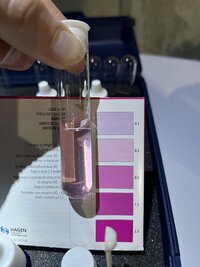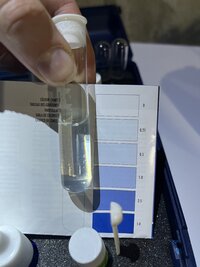@John q your comment about what’s repeatable got me thinking —- my water column and soil composition is correct. The reason I know is that there is zero indication for stunting/deformity and the dosing frequency (50ml for 50 gallons at water change and 10mL right at lights off (or 100% at water change and 10% daily) for macros and .015fe proxy of micros with lights on in concentrated csm b solution) is correct since tds is fixed at 108 pretty much always. That’s the hardest part: getting a long-term, sustainable (EI breaks earlier than lean but lean is more volatile to change).
The only hint of indicator that it is “off by a bit” is in Rotala green (partially why I bought 1 cup of wallichi to add with the Monte Carlo) is minor crinkles .. but the crinkles in the leaves aren’t “stunty”‘I think they are more related to the rate of off gas/accumulation from the earlier startup rather than GH/N/P/K/micro balance. Even though these are kind of the same, I’m not reacting to that with the Rotala green since the ones in front don’t show it just the ones in the back behind the Macrandra and rock (could just be squished). Not reacting to that one.
(structurally, I’d use more free soil on top of the bags in the future.)
All that’s left is temp/co2/light/flow. And I mean those are pretty easy after the massive learning curve.
Priortize “system health” over “anti-algae” and you have high light, higher temp, and co2 with lights (in soft water or a little ramp with harder water).
If you prioritize anti-algae you go low light, co2 ramp, and lower temp.
The sweet spot is system health combined with healthy plants as I think you can have healthy looking plants with poorer systemic health vs healthy looking plants and healthier systemic health.
I had said once that algae is a buffer … in the same way KH buffers against acid, algae buffers against “nasties” (I say nasties because plants “cleanse” the system of well we always say ammonia but I’m not convinced there’s not more than ammonia … so I call it nasties hahah). With low light and low temp, the algae can’t respond to pitfalls and inadequacies fast enough so they linger around in the water … with higher temp opportunities and higher light opportunities there is enough energy to clean the body of water and if your plant is missing something, then the Algae can make up for it quickly rather than waiting a week for you to see it (then you are a week with nasties and you’re shaving years off your fishies life). It’s rather simple - fix the problem and the plant takes foothold and the algae goes away. So you have 3 internodes of a stem plant of a problem? Or a single leaf of an epiphyte or rosette? Trim and move on 😂.
I mean that’s my thinking and so all my futzing around with light/co2 to find boundaries of system health compromised plant health (as we saw) … so now I’m bringing it back to “healthy-ish” (so visibly healthy plants but not necessarily as healthy as possible system) then I’ll test the last piece for system health (I am rather convinced 10h -12h photo is the way to go - I’ve done up to 20 in a healthy system with no I’ll effects (is why I did it at startup just to try it … it was fine but not worth it) - and I think 10h is the hands down best midpoint) which is the rubisco/co2 thing (letting pH rise during the last 4 hours of that 10h photo).
Edit … hmm … and as I write …. Wouldn’t it be perfect if the co2/rubisco thing works and we go to 12h photo and have 6h gas with low/descending pH and 6h gas off at high/ascending pH. All of this with temp flux up to maximum while ph is at minimum and then all the way back to minimum while pH is at maximum ….
The only hint of indicator that it is “off by a bit” is in Rotala green (partially why I bought 1 cup of wallichi to add with the Monte Carlo) is minor crinkles .. but the crinkles in the leaves aren’t “stunty”‘I think they are more related to the rate of off gas/accumulation from the earlier startup rather than GH/N/P/K/micro balance. Even though these are kind of the same, I’m not reacting to that with the Rotala green since the ones in front don’t show it just the ones in the back behind the Macrandra and rock (could just be squished). Not reacting to that one.
(structurally, I’d use more free soil on top of the bags in the future.)
All that’s left is temp/co2/light/flow. And I mean those are pretty easy after the massive learning curve.
Priortize “system health” over “anti-algae” and you have high light, higher temp, and co2 with lights (in soft water or a little ramp with harder water).
If you prioritize anti-algae you go low light, co2 ramp, and lower temp.
The sweet spot is system health combined with healthy plants as I think you can have healthy looking plants with poorer systemic health vs healthy looking plants and healthier systemic health.
I had said once that algae is a buffer … in the same way KH buffers against acid, algae buffers against “nasties” (I say nasties because plants “cleanse” the system of well we always say ammonia but I’m not convinced there’s not more than ammonia … so I call it nasties hahah). With low light and low temp, the algae can’t respond to pitfalls and inadequacies fast enough so they linger around in the water … with higher temp opportunities and higher light opportunities there is enough energy to clean the body of water and if your plant is missing something, then the Algae can make up for it quickly rather than waiting a week for you to see it (then you are a week with nasties and you’re shaving years off your fishies life). It’s rather simple - fix the problem and the plant takes foothold and the algae goes away. So you have 3 internodes of a stem plant of a problem? Or a single leaf of an epiphyte or rosette? Trim and move on 😂.
I mean that’s my thinking and so all my futzing around with light/co2 to find boundaries of system health compromised plant health (as we saw) … so now I’m bringing it back to “healthy-ish” (so visibly healthy plants but not necessarily as healthy as possible system) then I’ll test the last piece for system health (I am rather convinced 10h -12h photo is the way to go - I’ve done up to 20 in a healthy system with no I’ll effects (is why I did it at startup just to try it … it was fine but not worth it) - and I think 10h is the hands down best midpoint) which is the rubisco/co2 thing (letting pH rise during the last 4 hours of that 10h photo).
Edit … hmm … and as I write …. Wouldn’t it be perfect if the co2/rubisco thing works and we go to 12h photo and have 6h gas with low/descending pH and 6h gas off at high/ascending pH. All of this with temp flux up to maximum while ph is at minimum and then all the way back to minimum while pH is at maximum ….
Last edited:









